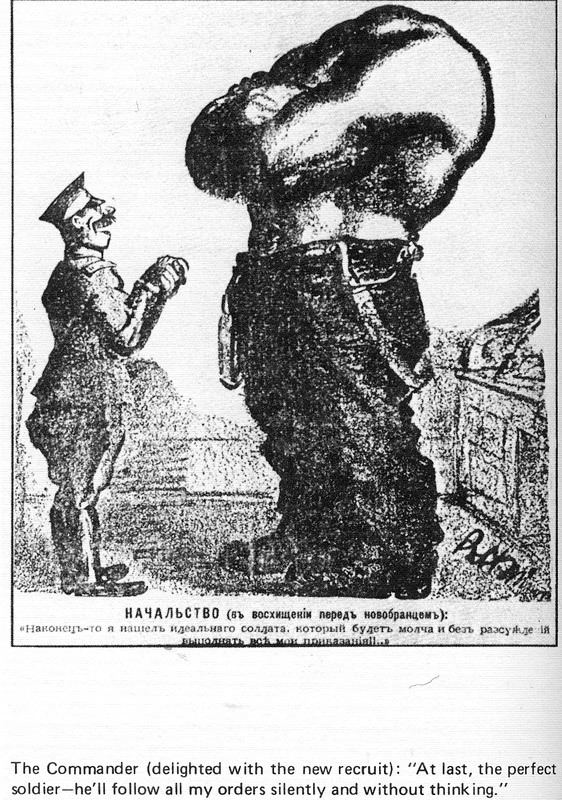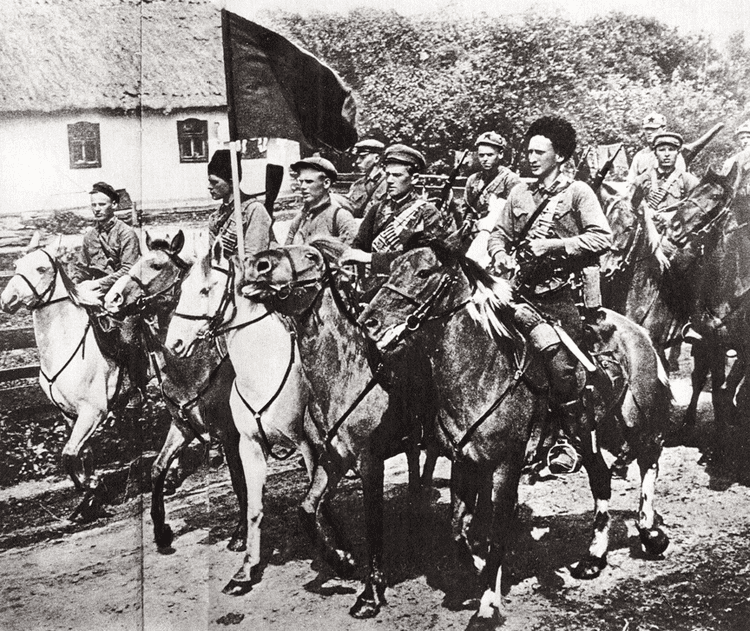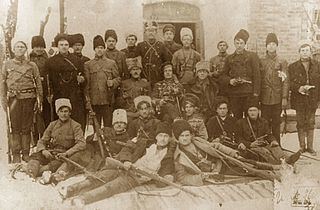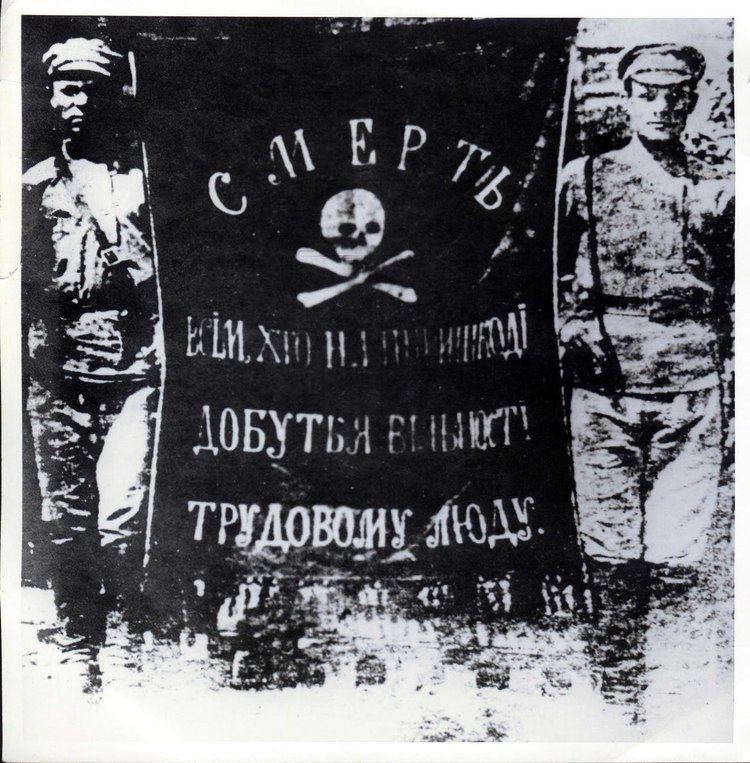Active 1918–1921 | ||
 | ||
Ideology AnarchismAnarchist communismMakhnovism Area of operations Present-day Ukraine, mostly Yekaterinoslav Governorate, especially Huliaipole; south-western oblasts of present-day Russia Strength 103,000 in December 1919 Allies temporary agreements with (Red) Soviet Russia, (Red) Soviet Ukraine, (Red) Soviet Crimea, temporary cease-fire with the Directory, agreements with Antonov revolt Battles and wars Battle of Peregonovka (September 1919) Similar | ||
The Revolutionary Insurrectionary Army of Ukraine (Ukrainian: Революційна Повстанська Армія України, Russian: Революционная Повстанческая Армия Украины", Revolyutsionnaya Povstancheskaya Armiya Ukrainy), popularly called Makhnovshchyna, less correctly Makhnovchina, and also known as the Black Army, was an anarchist army formed largely of Ukrainian peasants and workers under the command of the famous anarchist Nestor Makhno during the Russian Civil War. They protected the operation of "free soviets" and libertarian communes in the Free Territory, an attempt to form a stateless anarchist society from 1918 to 1921 during the Ukrainian Revolution.
Contents
- Nestor Makhno and the Insurrectionary Anarchist Army
- Red Army mutinies in Ukraine
- Campaign against Denikin and the White Army
- First repudiation of the alliance
- Bolshevik Makhnovist Treaty of Political and Military Alliance
- Second repudiation
- Organisation
- Commanders
- References

Nestor Makhno and the Insurrectionary Anarchist Army

Ukrainian anarchist guerrilla bands were active during the Russian Civil War. Some claimed to be loyal to the Ukrainian state, but others acknowledged no allegiance; all fought both Red and White Russians with equal ferocity in the opening stages of the Civil War. Of all the anarchist groups, the most famous and successful was that of the peasant anarchist leader Nestor Makhno, aka Batko ("Father"), who began operations in the southeastern Ukraine against the Hetmanate regime in July 1918. In September, he formed the Revolutionary Insurrectionary Army of Ukraine, or Anarchist Black Army, with arms and equipment largely obtained from retreating Austro-Hungarian and German forces. During the Civil War, the Black Army numbered between 15,000 and 110,000 men and was organized on conventional lines, with infantry, cavalry, and artillery units; artillery batteries were attached to each infantry brigade. Makhno's cavalry incorporated both regular and irregular (guerrilla) horse-mounted forces, and was considered among the best-trained and most capable of any of the cavalry units deployed by any side in the Russian Civil War. The Bolshevik government and Red Army commanders often referred to the Black Army as "Makhnovist forces", because they pointedly declined to accord the Ukrainian anarchists the status of having an army or a legitimate political movement. Volin described the Insurrectionary Black Army of the time (less its cavalry, which normally ranged far afield) as follows: The infantry, when it was not fighting, led the march of the army ... [The Black Army also used horse-drawn carts or] tachankas. Each of these vehicles, which were drawn by two horses, carried the driver on the front seat and two soldiers behind them. In some sections a machine-gun was installed on the seat between them. The artillery brought up the rear. A huge black flag floated over the first carriage. The slogans Liberty or Death and The Land to the Peasants, the Factories to the Workers were embroidered in silver on its two sides.

A main obstacle to the anarchist army, and one which it never overcame throughout its existence, was a lack of access to primary industrial manufacturing resources, specifically factories capable of producing large amounts of arms and ammunition. Denied large-scale arms shipments from the Bolshevik government in Moscow, and without arsenal manufacturing centers of its own, the Black Army was forced to rely on captures of munition depots and supplies from enemy forces, and to procure food and horses from the local civilian population.
Red Army mutinies in Ukraine

By early 1919, the Bolshevik government had withdrawn most Red Army forces from Ukraine after White successes in the south. The remaining Red Army troops who had stayed in various parts of Ukraine were suspicious of their commanders, and angry at the withdrawals from Ukraine, which they considered a defection from the revolutionary cause. At the end of July, 1919, Red Army detachments numbering some 40,000 troops in Crimea mutinied and deposed their commanders; many set out to join Makhno's anarchist Black Army. The mutiny was organized by some of Makhno's anarchist comrades who had remained commanders in the ranks of the Red Army, including Kalashnikov, Dermendzhi, and Budanov; these men also planned the transfer of forces. Large numbers of Red Army soldiers advanced from Novi Bug to Pomoshchnaya in search of Makhno's Black Army, bringing with them, as captives, their former commanders: Kochergin, Dybets and others. The mutineers joined Black Army forces at Dobrovelychkivka in the municipality of Kherson at the beginning of August 1919. For the Bolshevik government in Moscow, this defection was a major blow; since almost nothing remained of the Red Army in southern Ukraine and the Crimea, Bolshevik influence in the area vanished.
Campaign against Denikin and the White Army

Makhno and the Ukrainian anarchist Black Army, at first declared 'bandits' and 'outlaws' by the Moscow's Bolshevik government, were welcomed after General Denikin threatened to overrun Moscow in a drive towards the city in 1919. After concluding an agreement with the Ukrainian Directory, Makhno and his subordinate commanders made plans to turn the Black Army east and attack Denikin's White Army and its lines of supply, hoping to break through his lines.
The Black Army had been retreating to the west across Ukraine. But on the evening of September 25, 1919, it suddenly turned east, attacking the main forces of General Denikin's army. The first encounter took place late in the evening near the village of Kruten'koe, where the Black Army's First Infantry Brigade advanced towards White Army positions. Denikin's troops retreated to take up better positions. At first, Denikin believed the move was a feint or reconnaissance-in-force, and did not follow up, concluding that most of the anarchist army was still retiring to the west. However, in the middle of the night, all of Makhno's troops began an offensive to the east. The White Army's principal forces in the area were concentrated near the village of Peregonovka; the village itself was occupied by anarchist units. Intense fighting broke out, and the occupying anarchist forces began to lose ground, pressured by White Army reinforcements, including infantry regiments composed largely of young and fanatically anti-communist officers. Makhno's headquarters staff, as well as everyone in the village who could handle a rifle, armed themselves and joined in the fighting. On the approach of Makhno's cavalry forces, White Army troops retreated from Peregonovka. A fierce battle took place outside the town, including instances of hand-to-hand combat. A White regiment was forced to retreat, at first slowly and in an orderly way, but as the fighting moved near the Sinyukha river, it became a rout. The other regiments, seized by panic, followed them. Finally all of Denikin's troops in the area were routed; most escaped by swimming across the Sinyukha River, but hundreds died in the river and on its banks.
After this victory, Makhno's troops set out to attack Denikin's lines of supply. The fall of Aleksandrovsk to the Black Army was followed by Pologi, Gulyai-Polye, Berdyansk, Melitopol', and Mariupol'. In less than two weeks, all of southern Ukraine had been conquered by Black Army troops. Makhno's occupation of southern Ukraine, especially the regions bordering on the Sea of Azov, soon posed a threat to Denikin's entire offensive, as the supply base of Denikin's army was located in the region between Mariupol' and Volnovakha. When Berdyansk and Mariupol' were taken, immense stores of munitions were captured by anarchist forces. Because all the railroads of the region were controlled by the Black Army, no war material could reach Denikin's forces on the northern front. White Army reserve regiments stationed throughout the region were ordered to break the blockade, but were instead routed.
After a failed attempt to dislodge Black Army forces, Denikin shifted his campaign from the north to the south. The White Army's best cavalry troops, commanded by General Konstantin Mamontov and General Shkuro, were transferred from the northern front to the Gulyai-Polye region of Russia. Denikin's new strategy succeeded in driving out Makhno's forces from part of Ukraine, but at the cost of denuding forces opposing the Red Army. During October and November 1919, Denikin's troops were defeated in a series of battles by Red Army forces. His Caucasus regiments suffered the greatest losses, especially the Chechen cavalry and others, who died by the thousands. Toward the end of November, some of these troops mutinied, returning to their homes in the Caucasus. This in turn began a slow disintegration of Denikin's White Army. Some historians note that if the anarchist forces had not won a decisive victory at Peregonovka, blockading Denikin's lines of supply and denying the White Army supplies of food, ammunition, and artillery reinforcements, the White Army would probably have entered Moscow in December 1919. All through February, 1920 the Free Territory—Makhnovist region—was inundated with Red troops, including the 42nd Rifle Division and the Latvian & Estonian Red Division – in total at least 20,000 soldiers. After the souring and dissolution of Nestor Makhno's Revolutionary Insurrectionary Army of Ukraine with Bolsheviks the captured Red commanders and commissars were similarly summarily executed. However, Makhno usually preferred to release the disarmed enlisted men that were captured, as "proletarian brothers", with a choice of joining his army or returning home, after all commanding officers were executed. This happened to an Estonian Red Army unit that surrendered to Makhno in 1920. Viktor Belash noted that even in the worst time for the revolutionary army, namely at the beginning of 1920, "In the majority of cases rank-and-file Red Army soldiers were set free". Of course Belash, as a colleague of Makhno's, was likely to idealize the punishment policies of the Batko. However, the facts bear witness that Makhno really did release "in all four directions" captured Red Army soldiers. This is what happened at the beginning of February 1920, when the insurgents disarmed the 10,000-strong Estonian Division in Huliajpole. To this it must be added that the Revolutionary Insurrectionary Army of Ukraine included a choir of Estonian musicians. The problem was further compounded by the alienation of the Estonians by Anton Denikin's inflexible Russian chauvinism and their refusal to fight with Nikolai Yudenich.
First repudiation of the alliance
After the victories over the White Army, the Bolshevik government repudiated its alliance with Makhno and the Ukrainian anarchist movement, repeatedly attacking concentrations of Black Army troops, as well as ordering Chekist and Red Army reprisals against those believed sympathetic to the anarchists. In June 1920 the Cheka sent two agents to assassinate Makhno—one recruited from Ukrainian naletchiki, another a double agent who had previously worked for Makhno. However, the latter disclosed his mission before it could be carried out, and both were executed. Meanwhile, Red Army forces, vastly superior in numbers and equipment, steadily reduced areas of Russia under anarchist control.
By 1920, Leon Trotsky (as War Commissar of the Red Army) had resorted to terror tactics, ordering the death of thousands of Ukrainian villagers and peasants loyal to Makhno's Black Army. Trotsky also intentionally withdrew Red Army troops from their positions on the southern front, allowing Tsarist Cossack forces to overrun the southern Ukraine. At first, Makhno and the Black Army retreated, followed by a caravan of Ukrainian refugees. Attacking again, Makhno's forces surprised General Pyotr Nikolayevich Wrangel's counterrevolutionary regiments in southern Ukraine, capturing 4,000 prisoners and stores of weapons and munitions, and preventing Wrangel from seizing that year's grain harvest in Ukraine.
Bolshevik-Makhnovist Treaty of Political and Military Alliance
Trotsky once again offered an alliance, sending a plenipotentiary delegation from the Central Committee of the Bolshevik Communist Party, headed by Comrade Ivanov to propose a military and political treaty of alliance; Makhno agreed, subject to a pardon of all Anarchist prisoners throughout Russia. The treaty was drawn up and signed on October 15, 1920 at Starobel'sk by anarchist military and political representatives and the Bolshevik Communist delegation. The treaty, along with a Makhnovist delegation then traveled to the Bolshevik-held city of Kharkiv for official ratification and to plan a common military strategy. Using the arms and munitions previously captured from General Wrangel's infantry brigades in the southern Ukraine, Makhno and the Black Army went on to clear much of Crimea of Cossack cavalry, and helped force a retreat of Wrangel's remaining infantry brigades. After an unsuccessful northern offensive against the Red Army, Wrangel and the last of his forces were evacuated from Sevastopol by the British Navy on November 14, 1920.
However, the Bolshevik Communist government in Moscow initially refused to publish the Bolshevik-Makhnovist Treaty or acknowledge the existence of a formal alliance outside Ukraine. It also continued to denounce anarchism as an illegitimate political movement elsewhere in Russia, accelerating mass arrests and detentions of anarchists in all areas of the country under Bolshevik and Red Army control. After pressure by Makhno, the Central Committee in Moscow eventually published the military section of the Bolshevik-Makhnovist treaty, followed a week later by the political section. A fourth clause concerning the establishment of autonomous committees composed of workers and peasants for self-government of areas held by the Black Army was omitted.
Second repudiation
It soon became clear why Moscow had resisted the publicizing of the Bolshevik-Makhnovist treaty. On November 26, 1920, less than two weeks after completing their successful offensive against General Wrangel's White Army in the Crimea, Makhno's headquarters staff and several Black Army subordinate commanders arrived at Red Army Southern Front headquarters to participate in a joint planning conference with Red Army commanders. Upon arrival, they were arrested and executed on the spot by a Red Army firing squad; the Makhnovist treaty delegation, still in Kharkiv, was also arrested and liquidated. The Bolshevik then sent 5 regular Armies numbering more than 350,000 with armoured cars, artillery,aircraft, and armoured trains, with the purpose of destroying the Makhnovist movement. The Makhnovist army barely numbered 10,000 men continued to fight on making raids all across Ukraine and Southern Russia fighting constant battles with much larger and better equipped Red army units. In August 1921 the Makhnovist army ceased to be an organised force, numbering only 1,200-2,000 men scattered across Ukraine. A badly wounded Makhno with 77 of his men crossed the Dniester river to Romania in August 28, 1921. The last Makhnovist forces where destroyed in late 1922, and an underground Makhnovist presence would persist into the 1940s.
Argentine sociologist Christian Ferrer pointed out that components in exile from the Makhnovist army fought with the International Brigades during the Spanish Civil War. These Ukrainians were part of a company commanded by "Lieutenant Shevchenko" within the Battalion Mickiewicz -Palafox of the XIII International Brigade or the Dabrowski Brigade, which crossed the Pyrenees after the fall of Catalonia, and who participated in the resistance against Nazism.
According to the Franco-Bulgarian historian, Frank Mintz, even during the Second World War, the Makhnovist impact appeared as "Ukrainian guerrilla groups still brandish the black flag and fought against the Nazis and the Stalinists".
Organisation
In mid-1919, the Revolutionary Insurrectionary Army of Ukraine had a strength of some 15,000 men, organised into one cavalry and four infantry Brigades, a machine gun regiment with 5000 guns, and an artillery detachment. At its peak in December 1919, it had about 83,000 infantry, 20,135 cavalry, 1,435 machine guns, and 118 guns, as well as seven armored trains and some armored cars. It was organized into four Corps and the strategic reserve. Each Corps had one infantry and one cavalry Brigade; each Brigade had 3-4 Regiments of the appropriate type.
The structure of the RIAU was not that of a traditional army. Instead, the RIAU was a democratic militia based on soldier committees and general assemblies. Officers in the ordinary sense were abolished; instead, all commanders were elected and recallable. In theory, the RIAU relied on voluntary enlistment instead of conscription, however in practice conscription was used. Regular mass assemblies were held to discuss policy. The army was based on self-discipline, and all of the army’s disciplinary rules were approved by soldier assemblies.
This organizational structure was later used in organizing militias created by anarchists in the Spanish revolution and Spanish Civil War.
